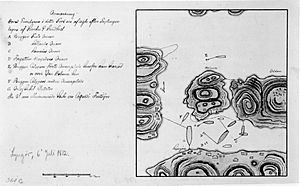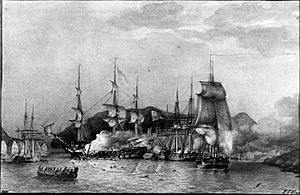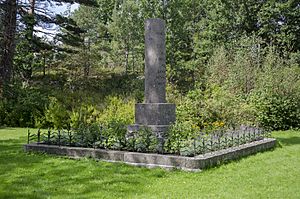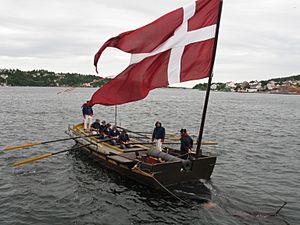Battle of Lyngør facts for kids
Quick facts for kids Battle of Lyngør |
|||||||
|---|---|---|---|---|---|---|---|
| Part of The Gunboat War | |||||||
 Battle of Lyngør, by C.W. Barth |
|||||||
|
|||||||
| Belligerents | |||||||
| Commanders and leaders | |||||||
| Strength | |||||||
| 1 ship of the line 3 brigs |
1 frigate 3 brigs |
||||||
| Casualties and losses | |||||||
| 9 killed 26 wounded 2 missing |
133 killed 88 wounded 1 frigate sunk |
||||||
The Battle of Lyngør was a sea battle that happened in 1812. It was fought between Denmark–Norway and the United Kingdom off the coast of Norway. This battle was a big defeat for Denmark-Norway. It also marked the end of their part in the Napoleonic Wars.
Contents
Why did the Battle of Lyngør happen?
In the early 1800s, Denmark-Norway tried to stay neutral. This meant they did not want to pick sides in the big wars between France and the United Kingdom. But in 1807, the British attacked and took over the entire Danish fleet. They thought Denmark-Norway might join France.
After this, the British set up a blockade (a naval barrier) in the Skagerrak sound. This stopped ships from moving between Norway and Denmark. It cut off Norway from supplies and trade. This blockade caused big economic problems for Denmark-Norway.
What was left of the Dano-Norwegian navy tried to break this blockade. After many small fights, their main ship was the frigate Najaden. A frigate is a fast warship. They built Najaden in 1811 using parts from older ships. Captain Hans Peter Holm commanded Najaden. Three smaller ships called brigs – Kiel, Lolland, and Samsøe – sailed with her.
The British wanted to completely stop Denmark-Norway's power at sea. So, they sent a strong fleet. This included the 64-gun ship-of-the-line Dictator. A ship-of-the-line was a very large, powerful warship. Three brigs also joined them: Cruizer-class brig-sloop Calypso, Podargus, and Flamer. Their goal was to find and destroy the last Dano-Norwegian warships.
What were the battle plans?
Captain James Steward, who led the British ships, wanted to find and sink Najaden. If he succeeded, Britain would control the trade routes. This would also end Denmark's role in the Napoleonic Wars. Steward was known for wanting to fight. He knew his large ship-of-the-line could easily beat a frigate in an open battle.
Captain Holm of Najaden had a different plan. He wanted to avoid fighting the British ships. He knew the local waters very well. He hoped to use this knowledge to escape Steward's pursuit. The Dano-Norwegian ships were hiding in a sheltered spot on the coast. However, this spot was not well protected. If a stronger enemy force attacked, their ships could get trapped. There was only one way out, and it was not strongly defended.
How the Battle Unfolded
Najaden was anchored near Sandøya island. Captain Holm felt safe there. He thought no British ship would risk sailing into the tricky, rocky waters. He even went ashore for a meal. From the hills, he suddenly saw the British ships heading his way.
He quickly rushed back to his ships. He ordered them to sail northeast towards Lyngør using an inner route. The British ship Podargus was leading. It seemed to have a local guide on board. But Podargus still ran aground (got stuck) on a rock. Captain Steward told Flamer to stay and help.
Smaller Dano-Norwegian boats immediately attacked Podargus and Flamer. More gunboats from Arendal joined the fight. A battery (a group of cannons) on Digernes island also fired at the two British brigs. Podargus and Flamer were damaged. But they managed to rejoin Dictator later.
Najaden sailed into the narrow sound of Lyngør. Captain Holm anchored his ship there. He thought Dictator could not follow him into the narrow sound. He believed the attack would come from smaller boats or over the land. So, he pointed his ship's side (broadside) towards the land.
However, Captain Steward sailed Dictator into the sound. He dropped an anchor behind his ship. Then, he ran Dictator ashore so its side was facing Najaden. He used the anchor rope to pull his ship into position. Dictator was now only about 35–40 metres from Najaden. Najaden could not turn. Its cannons were pointing away from the enemy ship. It was stuck.
Around 9:30 pm, Dictator fired a huge barrage at Najaden. This lasted about 15 minutes. It was like four tons of cannonballs hitting the ship. Najaden's main mast broke almost right away. A fire also started on the ship.
Dictator then fired at the two Danish brigs nearby. They quickly surrendered. The British captured Laaland and Kiel. But they left them behind after the two ships got stuck. The British did not burn them because their crews and wounded sailors were still on board.
Najaden began to tilt and take on water. The fire spread to the powder magazine (where gunpowder was stored). At 10:10 pm, the ship exploded. Within 45 minutes, Najaden had sunk. About 133 sailors died, and 82 were wounded. Captain Holm survived the battle. Sadly, he drowned in an accident a few months later.
The battle continued as Norwegian gunboats arrived in Lyngør. By 1:00 am, all nearby Norwegian gunboats were in the sound. They attacked the British ships. This forced the British to leave the captured Danish brigs. Captain Steward decided the situation was too dangerous. Dictator was pulled free around 2:00 am. But it got stuck again. Cannons had to be moved to the back of the ship to free it. This happened at 5:00 am.
Dictator and Calypso then sailed away. They left the sound, heading east. The Norwegian gunboats kept firing at them. The small boats caused a lot of damage to the British ships. But the tired rowing crews could not chase the sailing ships. The British ships escaped to the open sea.
The British lost 9 men killed and 26 wounded. The Danes reported about 300 men killed or wounded.
What happened after the battle?
The Battle of Lyngør was very important. It effectively ended Denmark's involvement in the Napoleonic Wars. Later, in the Treaty of Kiel, Denmark gave up control over Norway. This led to Norway's own independence movement. Norway then created its own parliament and constitution. The battle also freed up British naval resources. This allowed them to focus on fighting the French navy.
Remembering the Battle
In 2012, for the 200th anniversary of the battle, a replica (copy) gunboat was built. It was named Øster Riisøer III. A cannon, possibly from Najaden, was found in the harbour in 1995.
A play about the battle is performed in Lyngør every year. The sunken ship is also a popular spot for divers.
Images for kids










